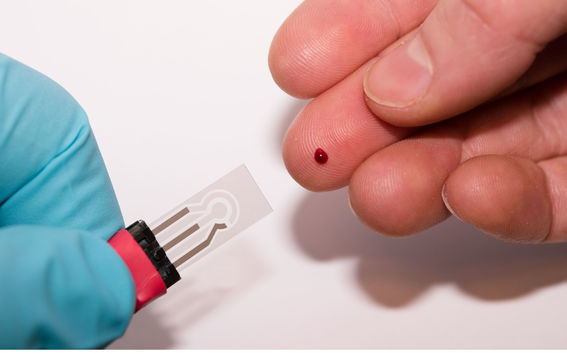A new measurement method for strong analgesics can reduce poisoning and overdose deaths

The new sensor is capable of accurately and very quickly measuring miniscule drug concentrations, leading to correct drug administration. Photo: Niklas Wester
Thanks to the development of a new sensor by researchers at Aalto University, it is now possible, for the first time, to quickly measure the concentration of tramadol, an opioid drug, from a drop of blood. The research has been conducted in cooperation with University of Helsinki and HUS Helsinki University Hospital. The new development represents a significant step forward, as tramadol use, similarly to other opioids, can easily lead to dependency, cause withdrawal symptoms, and even lead to overdose.
In fact, tramadol tops the list as the deadliest opioid. The new sensor can make more individual and effective treatment of pain possible. It may also help to diagnose and start the treatment of poisoning more rapidly.
Tramadol is a mild opioid, and along with codeine, the most-used opioid in Finland, for example, in the management of post-operative acute pain. It is used for chronic pain as well. Tramadol’s opioid effect is based on the metabolism from tramadol into O-desmethyltramadol (ODMT) metabolite in the liver. However, metabolic rates vary individually depending on genetic differences in metabolism of the liver and also possible combined actions of different drugs. Therefore, a dose of tramadol that might be necessary for one person’s pain relief may result in adverse reactions for someone else.
The expected affect of a drug can be examined by determining its concentration in blood. Currently, this is possible only through laborious and time-consuming laboratory testing. This means that, for the most part, calculating the correct dosage with strong analgesics relies on careful starting dose and small alterations in dosages based on patients’ reactions.
The sensor can also be used in first aid, when there is a need to determine the cause of poisoning and its severity very quickly.
The sensor is made from a new type of material combination, a carbon nanomaterial coated with a commercial Nafion polymer, allowing the substances being measured to be isolated from complex biological samples, like blood plasma. Developed in collaboration with Canatu Oy, who have made the measurement strip suitable for mass production, the new device will make it possible for measurements to be done using small, pin-prick blood samples taken from a fingertip.
During the sample reading, the drug is oxidized by changing the voltage between two electrodes, which releases the electrons from the oxidizing substance. The electrons can then be detected in the form of an electrical current. The voltage reading at which the current is detected depends on the substance being measured and this makes it possible to differentiate one substance from another. The stronger the detected current, the more concentrated the drug is in the sample being measured. This means that the substance can be identified and its concentration determined. There is currently an international patent pending for the new sensor.
In addition to tramadol, the method developed can also be used to measure other analgesics such as codeine, morphine, oxycodone, and fentanyl. The ultimate aim of the research is to achieve drug screening in unprocessed whole blood. However, the sensor's features need to be further developed and optimized before this is possible.
Simultaneous electrochemical detection of tramadol and O-desmethyltramadol with Nafion-coated tetrahedral amorphous carbon electrode. Elsi Mynttinen, Niklas Wester, Tuomas Lilius, Eija Kalso, Jari Koskinen, Tomi Laurila. Electrochimica Acta, https://doi.org/10.1016/j.electacta.2018.10.148
Further information:
Elsi Mynttinen
Aalto University
[email protected]
Niklas Wester
Aalto University
[email protected]
+358 50 460 2743
Eija Kalso
Professor of Pain Medicine, Faculty of Medicine
University of Helsinki
[email protected]
+358 9 4717 5885
- Published:
- Updated:
Read more news

Aalto ARTS alum Vidha Samya’s artwork featured at the Venice Biennale 2024
The Pavilion of Finland presents ‘The pleasures we choose’ at the 60th International Art Exhibition – La Biennale di Venezia until 24 November 2024.
IoT Forge donates EUR 1 million to the School of Engineering
The donation will be used for research and education on the Industrial Internet and digital twins.
Join us for the first Aalto Open Science Award Ceremony
All Aaltonians are welcome – no registration required!